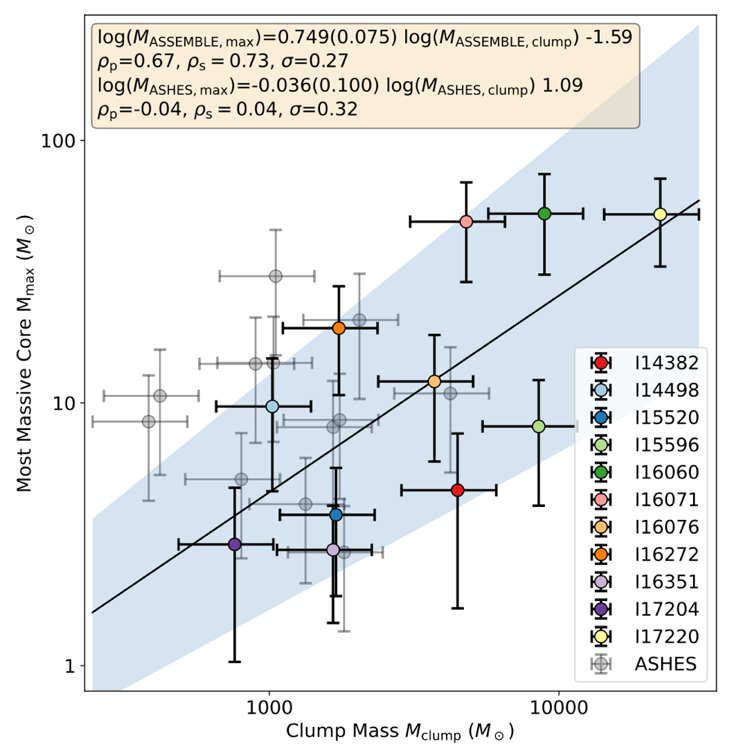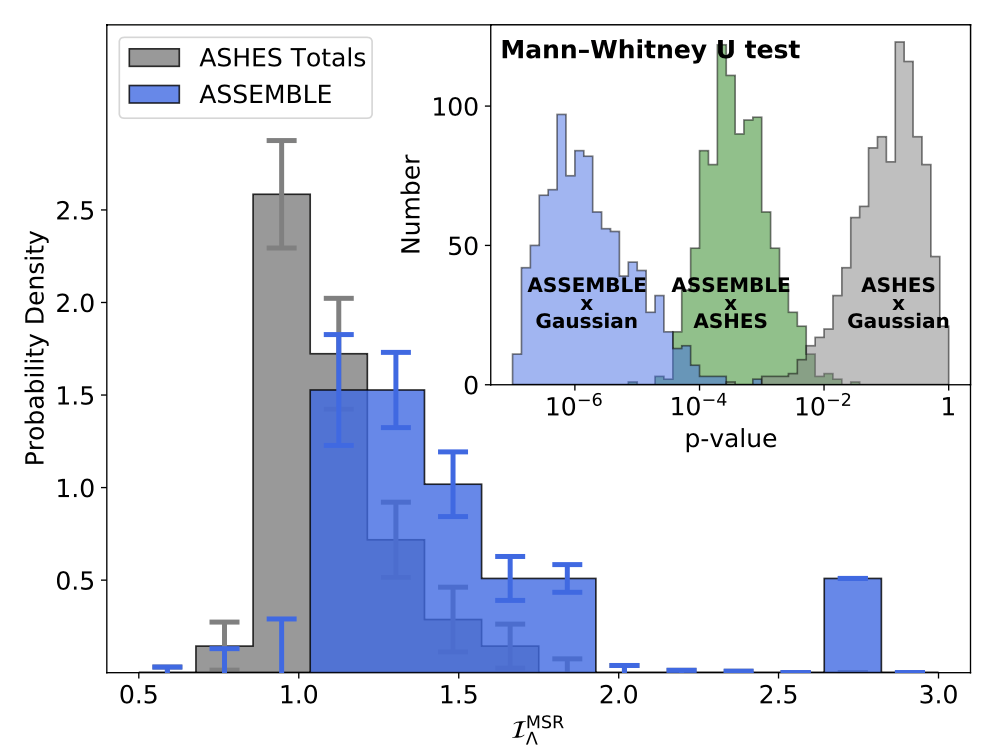A team of researchers from Shanghai Astronomical Observatory of the Chinese Academy of Sciences (CAS), National Astronomical Observatory of CAS, Peking University, Yunnan University, Guangzhou University, and other institutions, have jointly launched the ALMA Survey of Star formation and Evolution of Massive Protoclusters with Blue-profiles (ASSEMBLE) project. They revealed the growth in mass and density of cluster members, along with increasing proximity and mass segregation as the clusters evolve, and proposed a comprehensive formation and evolution scenario for these massive protoclusters. Their findings were published in The Astrophysical Journal Supplement Series.
Understanding mass assembly, including fragmentation and accretion processes, is challenging due to the time dependent and therefore dynamic nature of these processes. Observations offer only a series of snapshots of the entire lifetime of massive protoclusters. The predictions of theoretical models and numerical simulations with observations of massive clumps across a wide range of evolutionary stages have been compared. The research focusing on specific cases or stages has offered valuable insights.
ASSEMBLE utilized the Atacama Large Millimeter/submillimeter Array to observe 11 massive star-forming regions with a deep integration and a large mosaic. 11 massive clumps with Ultra-compact (UC) HII regions are chosen as the pilot sample. These clumps are thought to harbor massive protoclusters in a late stage, as evolved versions of 12 massive starless infrared dark clumps in another project called ALMA Survey of 70-um Dark High-mass Clumps in Early Stages (ASHES). “We’re excited to find highly consistent angular resolution, sensitivity, and field of view between two surveys, which is the best for comparative studies,” said XU Fengwei, the first author of the paper.
The ASSEMBLE team made a census of 248 dense cores in the 11 protoclusters and found that late-stage ASSEMBLE protoclusters show systematic increment in dense core mass and surface density compared to the early-stage ASHES protoclusters. They also found a clear correlation in the ASSEMBLE sample, between the clump mass and the most massive core mass, but not seen in the ASHES sample, which indicates a co-evolution regulated by continuous mass accretion from clump to core scale.
Besides, the ASSEMBLE team discovered that the dense cores in the ASSEMBLE protoclusters exhibit significantly closer proximity compared to those in the ASHES protoclusters. This finding aligns with the predictions of a theoretical dynamic model where dense cores are driven inwards by gravitational potential of parent massive clump. “Such model anticipates rapid mass accretion on the clump scale, exactly as viewed from our APEX HCN (4-3) and CO (4-3) line survey,” said LIU Tie from Shanghai Astronomical Observatory.
In star clusters, stars frequently exchange kinetic energy through binary interactions, leading to an equal distribution of this energy. As a result, larger mass stars lose energy and sink towards the center of the cluster, while smaller mass stars, gaining energy, are distributed more on the periphery. This phenomenon is referred as mass segregation. Debate persists over whether mass segregation is purely a dynamical effect or is inherited from the primordial protoclusters. Only a limited number of research teams have sought for the so-called “primordial mass segregation.”
Recently, the ASHES team reported no discernible primordial mass segregation in the initial stage of massive star cluster formation. However, it reported that a significant number of the ASSEMBLE protoclusters exhibit evident mass segregation. More interestingly, such dynamic evolution of mass segregation, observed by both ASHES and ASSEMBLE, cannot be explained by a pure dynamical effect since the dynamical relaxation timescale of the system is far longer than the lifetime of these protoclusters. In contrast, the observed mass segregation aligns well with the "competitive accretion” model where cores tend to accumulate more mass within deeper gravitational potentials.
"The observed primordial mass segregation shed light on the mass segregation problem in star clusters, and it also changes the traditional view of the origin of mass segregation,” said XU.
Based on the above findings, the ASSEMBLE team proposed a comprehensive dynamic perspective on massive protocluster evolution. At the initial stage, the protocluster originates from thermal Jeans fragmentation, with wide separation and no mass segregation. Subsequently, filamentary structure act as “conveying belts” and facilitate mass transfer towards the cores, by which the connection between the clump and core is gradually established. Concurrently, protostars form from dense cores, leading to the heating of gas and dust, clump transitioning into infrared weak state. Due to the effects of persistent global gravitational collapse and contraction, the protocluster becomes even tighter with narrower core separations and the mass segregation builds up in the late stage.
This study offers a more comprehensive understanding of the evolutionary trajectory of massive protoclusters. The ASSEMBLE team is embarking on the way to capture every moment in the life of protoclusters.
Figure 1. An example of ASSEMBLE observations. Left: Spitzer mid-infrared pseudo-color map overlaid with APEX 870 um emission and ALMA mosaicked observation field. Mid: ALMA 870 um continuum emission with 20 times higher resolution than the APEX. Right: protocluster with identified dense cores.
Figure 2. The colorized data points represent the ASSEMBLE clumps (late-stage), while the gray data points are the ASHES clumps (early-stage). The scaling relation between the masses of clumps and the most massive cores in each clump. The fitting results are shown on the top left. The shaded area shows the fitting uncertainty of the ASSEMBLE sample.
Figure 3. The number distribution and probability density distribution of core separations of ASSEMBLE (blue) and ASHES (green/gray) samples. The ASSEMBLE protoclusters have smaller core separations than the ASHES protoclusters do. The spatial resolutions of 0.02 pc are labelled in yellow shaded area.
Figure 4. The probability density distribution of mass segregation integrals (defined to measure the degree of mass segregation) of the ASHES (gray) and ASSEMBLE (blue). The upper right panel shows the p-values of statistical tests of mass segregation integrals between two samples (ASSEMBLE and ASHES) with a sample without mass segregation.
Figure 5. The evolutionary picture of massive protocluster evolution, from infrared dark (left), to infrared weak (mid), and to infrared bright (right). The blue and orange circles indicate the prestellar and protostellar cores. The black stars indicate OB stars. The black arrows indicate gas infall motion.





